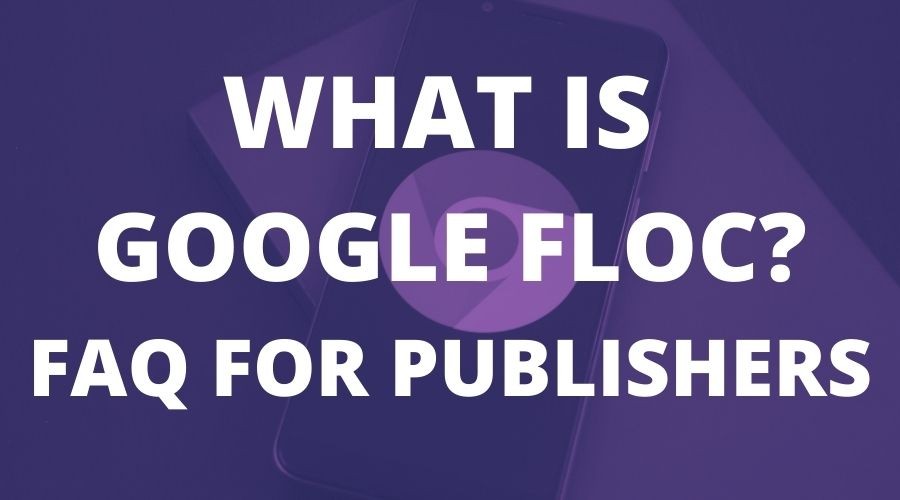
This post was most recently updated on January 18th, 2023
Increasing transparency and privacy is a priority for ad platforms as well as web browsers.
These new measures are Google’s way of replying to those same concerns raised by other browsers.
Earlier this year, Google announced its breakup with third-party cookies but also noticed a need to create advertising solutions in order to circumvent ad platforms from exploiting other, more intrusive tracking practices like browser fingerprinting.
The outcome of these efforts led to the Google Chrome Project called “FLoC” aka Federated Learning of Cohorts.
The Google FLoC approach would allow browsing data to reside within each individual browser instead of being aggregated and passed between sites.
FLoC would then allot individual browsers to bigger groups (or cohorts) of tonnes of users based on that browsing data.
Google FLoC is the chrome API allowing publishers and advertisers to target users anonymously by interest group based on their past browsing and behavior, etc.
It is only GDPR compliant when the user gives consent to their data processing and collection. For your EU users out there, that happened with a CMP (consent management platform).
Consent Management Platform is the popup you see on the website that asks for consent for data tracking.
For those EU users that are protected by GDPR consent strings that they see on all these websites, there’s an initiative called the privacy sandbox.
The Privacy Sandbox pushes the CMP to the browser level rather than the individual website level so that users can give consent or not give consent once vs an indefinite amount of times via all the websites that they look at.
What you need to know is that consented users are worth more than non-consented users.
If the user does not consent, then they will only be shown non-personalized ads.
These ads can only target via contextual advertising on whatever is on the page.
What’s the catch here is that interest-based advertising via options like Google FLoC monetizes much higher than non-personalized ads.
We’re talking about 5X to 10X more with Google FLoC here. This is a big difference for publishers and advertisers.
For advertisers, it’s a more effective way to target via interest.
If the CMP goes browser level and consent rates drop, we see publishers respond by having paywalls for all users that do not give consent.
EU users will then have to decide if they are going to pay a subscription for the websites that they like to browse or are they going to whitelist this website to consent to tracking just for the websites that they use most of the time.
As of now, Google is working on a better solution for FLoC that is more GDPR compliant for non-consented users.
From a privacy perspective, the main takeaway is that the user’s browsing history will no longer be shared.
Instead of publishers being able to track their subscriber’s browser history as they move from site to site, FLoC holds the person’s browser history and doesn’t secure it for anyone, including Google.
The previously collected data offered to target options in terms of affinity audiences and in-market audiences, as well as the reporting and tracking of conversions.
Before getting into that, let’s cover some of the bad reps that Google FLoC is getting from the majority of publishers.
Google FLoC has been getting a bad rep and pushback from both publishers and advertisers since it has been launched.
FLoC is criticized for developing complex privacy concerns as it can be paired with more intrusive measures of tracking (browser fingerprinting) that it was aiming to bypass.
As a result, some might be tempted to continue tracking people through other invasive ways & later add Google FLoC info on top of it for a more comprehensive picture.
Additionally, even though the browser will only share data with specific sites as part of a bigger group, some of these sites will be able to classify particular users (e.g., those who log in or buy something).
In other words, individual user data will still be used to infer information about a larger cohort.
This data could also be ultimately exchanged on a bigger scale.
As Google Ads has terms & conditions in place within its platform, this is a major concern, but since FLoC is a Google Chrome product, it is essential to keep in mind that it would be providing stats to other ad managers and thus is also of concern.
Ads cannot be targeted to cohorts including any kind of sensitive topic niche websites.
Google’s policy on personalized advertising states that:
‘While employing interest data or user behavior to present more relevant advertising content, it is necessary to handle this information appropriately.’
We recognize that certain interests are highly sensitive & targeting these cohorts can impact or influence users in a negative way.
Cohorts falling into the following categories will not be accessible to publishers:
Identity & Beliefs: Ads cannot target any user based on categories like systemic discrimination or prejudiced stigmas.
Accessing Opportunities: Ads cannot restrict access to opportunities based on cultural bias.
Struggles or Hardships: Ads shouldn’t target users based on the struggles they may be facing.
Sexual Preferences: Ads shouldn’t target anyone based on their sexual experience.
Google’s Privacy Sandbox is meant to enhance user privacy sans third-party cookies while still sustaining vital ad functions.
This browser standards-based initiative where browsers can still be granted access to browser-related information legally.
The Privacy Sandbox and Google’s big stake in the advertising ecosystem is another means to resume programmatic advertising functions like reporting, retention, detailed targeting sans third-party cookies.
Google’s Privacy Sandbox does maintain a ‘data integrity budget’ which has been predefined already to secure user’s privacy.
Google FLoC facilitates detailed targeting through cohorts rather than tracking each user’s history, behaviors, etc.
Just like CAPTCHA, there’s a ‘Privacy Pass’ now. It uses cryptographic tokens that detect and cease ad fraud through the use of trust tokens.
The Privacy Budget API stops Browser Fingerprinting by limiting the volume of user data that the site can collect from the sandbox.
Conversion Metric API stores and shares all the stats resulting from ad clicks like landing page traffic, engagement stats, purchases, etc.
Remarketing aka FLEDGE which is short for ‘First locally-Executed Decision over Groups Experiment’ supports remarketing campaigns within privacy standards.
As Google is still testing out FLoC and we are likely to see few updates soon, here are the main takeaways for publishers:
#1. Cookieless Future: With the death of third-party cookies and a future of ‘cookieless targeting‘ the need for first-party data is crucial. FLoC is Google’s statement for letting go of third-party cookies and user behavior targeting.
You need to pay close attention to Google’s ever-changing initiatives!
#2. Non-Chrome Users: Since Chrome does not have the entire market you can still plan other approaches for non-chrome users.
#3. Google’s Competitive Edge: Chrome takes a win here with the Google privacy sandbox. These updates will impact the competition between Ad Exchange, AdSense, etc that may disrupt the choices available to publishers.
#4. Ever-Changing: Using FLoC cohorts currently captures 95% of the conversion value that’s delivered through third-party cookies. However, Google’s Privacy Sandbox is still going through updates and testing for optimizing metrics like retargeting, conversions, engagement, and attributions.
#5. The Power of 1st Party Data: Post the third party cookie apocalypse, the need for acquiring first-party data skyrocketed. So, why is 1st party data more important now?
Stats have shown that it can help boost CPMs (cost per impressions) rates.
Growing signups and registration rate metrics are worth considering to always stay ahead of the unpredictable future that the ad-tech industry holds.
Despite the launch, Google FLoC still needs some tweaks and is likely to evolve based on the incoming feedback & user experience.
Google states that initial trials showed decent results for advertising platforms looking to upgrade their targeting system.
Our publishers need to take note that first-party cookies will not be affected by the so-called Cookie Apocalypse, as it has become popular in the ad-tech industry.
That’s the main reason why many are turning to first-party data now.
Having your websites tagged with the universal Google Ads tag is one of the recommendations that Google themselves make.
Are you new here looking to skip the ‘Cookie Apocalypse’ and supercharge your ad revenue?
Don’t worry, we can help!
Embrace the cookieless future with Monetize More. Get in touch with us today to get started.

Kean Graham is the CEO and founder of MonetizeMore & a pioneer in the Adtech Industry. He is the resident expert in Ad Optimization, covering areas like Adsense Optimization,GAM Management, and third-party ad network partnerships. Kean believes in the supremacy of direct publisher deals and holistic optimization as keys to effective and consistent ad revenue increases.
10X your ad revenue with our award-winning solutions.